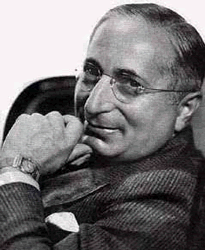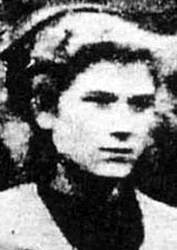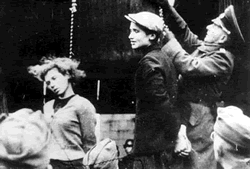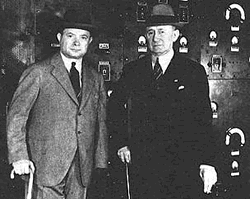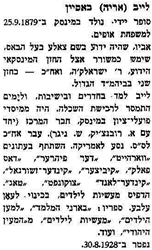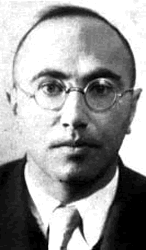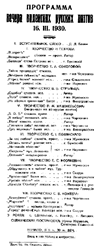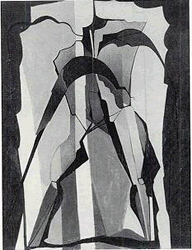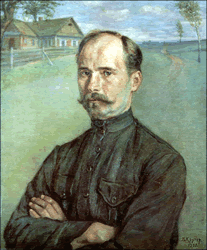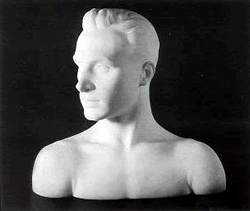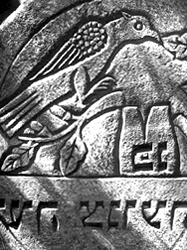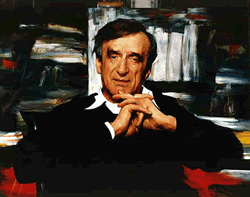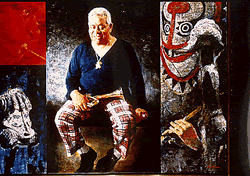LOUIS B. MAYER (1885 - 1957): Born in Minsk, Russia. Originally was a scrap metal dealer, then switched to film exhibition and distribution. He formed the Alco Company, then merged with Samuel Goldwyn in 1924 to form METRO-GOLDWYN-MAYER. His company with its emphasis on glamour, wholesome entertainment, and elaborate productions, was the envy of every other movie mogul.
http://www.cinerhama.com/jewish/history01.html
(Lazar Meir, Eliezer Mayer)
movie executive
Born: 7/4/1885
Birthplace: Minsk, Russia
From 1924 to 1951, Mayer reigned over Metro-Goldwin-Mayer (MGM). With his production supervisor, Irving Thalberg, he made MGM a powerful defining force in the motion picture industry of the 1930s and 1940s. His early successes include Ben Hur (1926) and Grand Hotel (1932). He received a Special Academy Award in 1950 for his contributions. Though domineering in management style, he was appreciated by the many actors whose careers he launched.
Died: 10/29/1957Born Eliezer (Lazar) Mayer on July 4, 1885 in Minsk (now in Belarus),
three years later his parents moved with him to Saint John, New Brunswick, where Mayer Sr. became a junk dealer and his wife sold chickens door to door
after graduating from elementary school, Mayer joined his father's business, which had become a profitable scrap metal operation
Louis set up his own junk business in Boston, and in 1904, he married the daughter of a local kosher butcher
in 1907 Mayer bought a small rundown motion picture theater in Haverhill, Mass.
He renovated the auditorium and announced a policy of top-quality films only
within a few years he owned the largest theater chain in New England
by 1914 he had branched out into distribution and the following year he made a huge profit out of distributing Griffith's The Birth of a Nation in New England
in 1916 he moved to Los Angeles and formed his own producing company, which in 1924 after a series of mergers became known as Metro-Goldwyn-Mayer (MGM)
as production chief of MGM from 1924 to 1951, he discovered many of the screen's greatest stars, producers, writers, and directors.
instrumental in the founding of the Academy of Motion Picture Arts and Sciences in 1927
ruled MGM as one big family, rewarding obedience, punishing insubordination, and regarding opposition as personal betrayal
in the 30s and 40s, Mayer was the most powerful magnate in Hollywood
his annual salary (plus bonuses) of more than one and a quarter million dollars, made him the highest paid person in the United States
a staunch conservative, he was active in politics and for several years was the California state chairman of the Republican party
he was ousted in a power struggle with Dore Schary, his former aide, in 1951
among his successes were:
The Big Parade (1925)
Ben Hur (1926)
Grand Hotel (1932)
Dinner at Eight /i> (1933)
the Andy Hardy series
biography: Hollywood Rajah (1960) by Bosley Crowther, Mayer and Thalberg (1975) by Sam Marx
Sam Goldwyn said of his office: "You need an automobile to reach the desk."
B.P. Schulberg gave him the title: "Czar of all the rushes."
Herman J. Mankiewicz: "He had the memory of an elephant and the hide of an elephant. The only difference is that elephants are vegetarians and Mayer's diet was his fellow man.
"The only reason so many people attended his funeral was they wanted to make sure he was dead." -anonymous
Bob Hope: "Louis B. Mayer came out west with twenty-eight dollars, a box camera and an old lion. He built a monument to himself---the Bank of America."
quotes:
to a complaining writer, "The number one book of the ages was written by a committee, and it was called The Bible"
to Gottfried Reinhardt, who wanted to make a non-commercial picture, "You want to be an artist, but you want other people to starve for your art."
the success of the Andy Hardy movies didn't delude Mayer into thinking they were great movies: "Don't make these pictures any better. Just keep them the way they are."
"Look out for yourself or they'll pee on your grave."
books:
Hollywood rajah; the life and times of Louis B. Mayer (1960) by Bosley Crowther
Mayer and Thalberg : the make-believe saints (1975) by Samuel Marx
All the stars in heaven : Louis B. Mayer's MGM (1981) by Gary Carey.
Hollywood East : Louis B. Mayer and the origins of the studio system (1992) by Diana Altman
Merchant of dreams : Louis B. Mayer, M.G.M., and the secret Hollywood (1993) by Charles Higham
http://schwinger.harvard.edu/~terning/bios/Mayer.html
#b-min_2:
Masha Bruskina
(Bruskin) was born in Minsk, in the Soviet Union, in 1924. Born into
a Jewish family she was forced to live in the Minsk ghetto with her
mother soon after the arrival of the German Army in July 1941.
Although only seventeen Masha, an ardent member of the Communist Party,
joined the Minsk resistance movement. She volunteered as a nurse at
the hospital in the Polytechnic Institute, that had been set up to care
for wounded members of the Red Army. As well as caring for the soldiers
she helped them escape by smuggling into the hospital civilian clothing
and false identity papers.
One of the patients informed on Masha and on 14th October she was arrested
by the German authorities. She was tortured for several days but refused
to give the names of other members of her group.
In order to frighten the people of Minsk into submission, the commander
of the 707th Infantry Division, decided to hold a public hanging. On
26th October 1941, Masha Bruskina and two other members of the resistance,
16 year old Volodia Shcherbatsevich and First World War veteran, Kiril
Trus, were executed in front of the gates of a local yeast factory.
http://www.spartacus.schoolnet.co.uk/2WWbruskina.htm
#b-min_3:
Lev Izrailovich Volshtein
(b. 1908) Born in Minsk (Belorussia). Studied at Leningrad Academy of
Arts/Institute of Proletarian Visual Arts 1925-30. Active in Leningrad.
Began exhibiting 1930. Important shows include Artists of the Russian
Federation over Fifteen Years, Leningrad, 1932; All-Union Art Exhibition,
Moscow, 1947. Taught at Leningrad Art Tekhnikum 1932-34; Repin Institute
1946-48. Also a graphic artist. Died 1980s.
www.autowrite.plus.com/artists.html
#b-min_4:
David Sarnov
Born in Minsk
in 1891, is an acknowledged pioneer of radio broadcasting in America.
His chairmanship of the Marconi Wireless Telegraph Corporation was followed
by taking over of the world-famous gramophone company His Master´s
Voice. During World War II as a Brigadier General, Sarnov became communications
adviser to General (later President) Eisenhower. Died in 1971
http://minsk.usembassy.gov/html/us_remembers.html
#b-min_6:
Yakov Borisovich Zel'dovich
was born in Minsk, Belorussia (Belarus) on 8 March 1914. At age 17 he
began working as a laboratory assistant at the Institute of Physics, the
Institute of Chemical Physics, in Leningrad.. Zel'dovich was almost entirely
self-taught, eventually reaching the level of Academician (the highest
rank in Soviet academia) and later becoming professor at Moscow State
University without ever received a regular college degree.
Zel'dovich had a remarkably versatile intellect, and during his life explored
and made major contributions to a wide range of scientific endeavors.
During the 1940s he advanced the state of the science of combustion and
detonation. He developed a more sophisticated theory of detonation that
accounted for features not previously explained, and correctly predicted
features that had not yet been observed. The modern theory of detonation
accordingly is called ZND theory (Zel'dovich-von Neumann-Dohring).
In a series of seminal papers written in collaboration with Yuli Khariton
in 1939-40, he explored the basic principles of fission chain reactions
in both fast and moderated assemblies.
Zel'dovich became the first head of the theoretical department of Arzamas-16,
the "Soviet Los Alamos", in 1946. That same year he developed
a report with Isaak Gurevich, Isaak Pomeranchuk, and Khariton on the feasibility
of releasing energy through nuclear fusion triggered by an atomic explosion
and presented it to Igor Kurchatov. This report was published in 1991
in Uspekhi Fizicheskikh Nauk. under the title "Ispol'zovanie iadernoi
energii legkikh elementov" ("Utilization of the nuclear energy
of light elements").
Zel'dovich led the theoretical work on both the first Soviet atomic and
hydrogen bombs. In the course of his work on nuclear weapons, Zel'dovich
did ground-breaking work in radiation hydrodynamics, and the physics of
matter at high pressure. This research served as the basis for his collaboration
with Yuli P. Raizer in writing Physics of Shock Waves and High-Temperature
Hydrodynamic Phenomena, a marvelously lucid physics text and by far the
best text on radiation hydrodynamics available. Originally published in
English in 1966 by Academic Press, it is now (2002) available in a low
cost paper back reprint from Dover.
From a focus on particle physics in the 50s, he went on in the later phase
of his career he concentrated on astrophysics, becoming head of the division
of relativistic astrophysics at the Sternberg Astronomical Institute.
Zel'dovich combined astrophysics with his particle physics experience
to become a leader in attempts to relate particle physics to cosmology.
With Rashid Sunyaev he proposed what is known as the Sunyaev-Zel’dovich
effect, an important method for determining the Hubble constant from the
effect of gas in galaxy clusters on the microwave background radiation.
He was elected to the Soviet Academy of Sciences in 1958, named laureate
of Lenin, and was made a Hero of Socialist Labor (the highest Soviet civilian
award) three times. He garnered numerous international awards: he was
elected to honorary membership of the National Academy of Sciences, of
the Royal Society, and several other national societies. He was the 1983
Bruce Medalist (awarded by the Astronomical Society of the Pacific). Zel'dovich
died suddenly on 2 December 1987. See his obituary published in Soviet
Astronomical Letters 14, 121-2 (1988).
http://216.239.39.104/custom?q=cache:KILXWIFhKssJ:nuclearweaponarchive.org/Russia/Zeldovch.html+born+in+minsk&hl=en&ie=UTF-8
#b-min_7:
Dorophey
Bokhan
http://www.rkc.lt/paveldas/bokhan/bokbioe.html
Along with Viachiaslav Bogdanovich (1878-1941) Dorophey Bokhan is the
most important figure in Russian literary and public life of Vilnius
in period between two wars. Poet, critic, essayist was born in Minsk,
studied in Polotsk military school, graduated from military college
in Petersburg, served in artillery. Since the middle of ninetieth of
XIX century he devoted himself to journalism.
Program of poetry party
organized by D. Bokhan. 1930 In different newspapers
and in poems collection "From Polish Poetry" (Minsk, 1905)
he published many translations of Polish verses and prose. In Vilnius
he issued a book "Adam Mickevich. Biographical essay" (1911)
with translations of well known sonnets "Bakhchisarai" and
"Ruins of Castle in Balaklava". The same publishing house
"Editor" published biography of T. Shevchenko compiled by
Bokhan. In December of 1920 he with his family escaped from Smolensk
to Vilnius belonging at that time to Poland. Here he actively participated
in Russian organizations, arranged different lectures and literary parties,
contributed himself to "Vilenskoje utro" ("Vilnius Morning"),
"Nasha zhizn" ("Our Life"), "Nashe vremia"
("Our Time"), "Russkoe slovo" ("Russian Word")
newspapers.. He was a publishing redactor of "Iskra" ("The
Spark") newspaper (in 1936-1937 it became "Novaja Iskra"
- "New Spark"), of Belorussian, Russian and Ukrainian magazine
"Narodnaja niva" ("People's Field"), of literary
monthly magazine "Utes" ("The Rock", 1931), participated
in Russian press of Warsaw. His daughter Sophia Bokhan played in public
with his verses, stories and essays. In his traditionally arranged stories,
poems, essays, lectures and notes Bokhan propagandized fundamental values
of Russian culture, criticized Bolshevik cultural politic and avantguard
artistic explorations associated with social experiments. In 1939 Soviet
authorities arrested him. Then he got to Polish army commanded by general
V. Anders and was killed in it's ranks defending oilfields in Iran and
Iraq against German troops.
#b-min_8:
WLADYSLAW
STRZEMINSKI
http://www.culture.pl/en/culture/artykuly/os_strzeminski_wladyslaw
Polish art
theoretician, painter, designer of "functional" prints, pioneer
of the Constructivist avant-garde of the 1920s and 1930s, creator of
the theory of Unism. Born 1893 Minsk in Belarus; died 1952 in Lodz.
Between 1911 and 1914, Strzeminski studied at St. Petersburg's Military
College of Engineering. He was heavily wounded in 1916 while serving
as an officer of the engineering corps during World War I, and eventually
lost an arm and a leg because of the wounds. In 1918, he attended classes
at the First Free State Workshops (SVOMAS) in Moscow, where he first
made contact with Casimir Malevich and Vladimir Tatlin. In 1919 he began
working at the Department of Fine Arts (IZO) of the People's Educational
Commissariat in Minsk; he also became a member of the Moscow Governing
Council for Art and the Artistic Industry. In 1919-1920 he worked with
the Government Department of Education in Smolensk, where together with
his wife, Katarzyna Kobro, he lead an artistic workshop (IZO-studio)
and additionally joined the UNOVIS group. Strzeminski presented his
Constructivist works at exhibitions in Moscow, Ryazan, and Vitebsk.
In 1921 he settled in Vilnius and began teaching illustration, initially
as part of the Lukasinski Military Graduate Seminars and later at the
middle school in Vileyka. In 1922-23 and 1925-26 he worked with the
periodical "Zwrotnica" ("Junction"), publishing,
among other articles, his "Notatki o sztuce rosyjskiej" ("Notes
on Russian Art" - 1922, no. 3; 1923, no. 4). In 1923 he worked
with Vytautas Kairiukstis in organizing the Exhibition of New Art in
Vilnius, which was in effect the starting point for Polish Constructivism.
Between 1924 and 1926 he taught drawing in Szczekociny and took a job
as a middle school teacher in Brzeziny. Strzeminski was one of the initiators
of the GRUPA KUBISTOW KONSTRUKTYWISTOW I SUPREMATYSTOW "BLOK"
("BLOCK" GROUP OF CUBISTS, CONSTRUCTIVISTS, AND SUPREMATISTS
(1924-26) and two groups which built on this organization's program,
namely PRAESENS (1926-29) and A.R. (1929-36). "Blok" the magazine
published Strzeminski's texts promoting principles of avant-garde art,
and Strzeminski was a participant in all domestic and international
appearances/exhibitions of the Polish Constructivist avant-garde.
In 1927, a solo exhibition of Strzeminski's work was organized in Warsaw.
That same year the artist presented his work at the Machine Age Exhibition
in New York. In 1927-1928 he taught at the vocational middle school
in the town of Koluszki, where he devised an original curriculum for
the training of designers. In 1931 he settled in Lodz where he became
a highly active member of the local chapter of the Association of Polish
Visual Artists. Strzeminski used the pages of the periodical "Forma",
the association's official publication, to disseminate his views about
new art, among other ways by entering into a debate about Leon Chwistek's
idea of "strefizm" (loosely translated as "Zonism").
Strzeminski was also headmaster of the Public School of Continued Education,
within which he pursued his novel concept of "functional"
printing. In 1932 he became a member of the international, Paris-based
Abstraction-Création group. Strzeminski was also an animator
for and co-creator of the International Collection of Modern Art, made
available to the public at the Museum of Art in Lodz in 1931, and in
1932 received a Lodz Municipal Arts Prize. In 1933 he initiated the
creation of the GRUPA PLASTYKOW NOWOCZESNYCH (GROUP OF MODERN VISUAL
ARTISTS), which brought together representatives of avant-gardes of
various provenance and profile.
In 1945 he became a lecturer at the State Higher School of the Visual
Arts (SHSVA) in Lodz, of which has was also a co-founder. He continued
to pour his energies into this institution and one of his achievements
was to create a Department of Spatial Visual Arts. That same year he
donated much of his output to the Museum of Art in Lodz. In 1948 Strzeminski
designed the Neo-Visual Room, which is today an integral part of the
museum's permanent exhibition.. In 1950 Strzeminski was stripped of
his position at the SHSVA by decision of the Ministry of Culture and
Art for failing to respect Socialist Realist doctrine.
In 1956/57 Lodz and Warsaw hosted posthumous exhibitions of the work
of Strzeminski and his wife, Katarzyna Kobro. The artist's book titled
"Teoria widzenia" ("A Theory of Vision"), written
around 1948-1949, was published in 1958. A collected volume titled "Wladyslaw
Strzeminski. In Memoriam" (Lodz, 1988) and "Materials from
a session organized in 1993 by the Museum of Art in Lodz on the 100th
anniversary of the artist's birth" (Lodz, 1994) were devoted to
Strzeminski's lifetime achievements as an artist. In 1993 the Museum
of Art in Lodz organized a monographic exhibition of the artist's oeuvre.
In addition, Strzeminski's works were shown at numerous international
exhibitions of avant-garde art, including CONSTRUCTIVISM IN POLAND 1923-1936.
BLOK - PRAESENS - A.R. at the Museum Folkwang Essen, Rijksmuseum Kroller-Müller
Otterlo, Stuttgart 1973.
Strzeminski's creative stance was a product of Cubist, Purist, and Neoplasticist
influences. Constructivism was particularly important in shaping his
concept of art, though at the same time he opposed the Constructivist-supported
motto stating that art should be subject to social utility. Instead,
Strzeminski defended the idea of the autonomy of art and the right to
"laboratory conditions" in artistic experimentation. The artist
accepted the need for blending the order inherent in art with the order
of social reality, but viewed art as having a modeling role in relation
to all forms of human activity.
He pursued his aims by painting canvasses, as well as by creating typographic
schemes, producing architectural and urban designs, and engaging in
art criticism and theorization. His essays titled UNIZM W MALARSTWIE
/ UNISM IN PAINTING (1928), KOMPOZYCJA PRZESTRZENI, OBLICZENIA RYTMU
CZASOPRZESTRZENNEGO / COMPOSITION OF SPACE, CALCULATIONS OF SPACE-TIME
RHYTHM (1932, written jointly with Katarzyna Kobro) constituted a lecture
on the principles of creating paintings, sculptures, and architectural
structures that would be integrated with each other and constitute a
harmonious whole; DRUK FUNKCJONALNY / FUNCTIONAL PRINTING (1935) on
the other hand discussed the principles of modern printing. Strzeminski
designed the typographic scheme for all the publications of the "a.r."
library, introducing a styling similar to visual poetry.
He also made a fundamental contribution to the history of the world
avant-garde through his theory of Unism. In 1927 he formulated the theory
in relation to painting, and subsequently extended its theoretical application
to sculpture, architecture, and typography in the years 1931-1933. The
general principle in Unism, relating to all forms of artistic _expression,
was the requirement for "unity between the artwork and the place
of its creation". In painting this meant accenting the complete
autonomy of the painting as a flat quadrilateral defined by a frame
and thus separated from its surroundings, and thus fully enclosed within
itself. At the base of Unism lay the principle of the complete unity
of paintings based on laws relating solely to them, paintings constituting
optical unities deprived of all contrasts. Strzeminski's explorations
into the full integration of the painting's surface through elimination
of any forms of dynamism or illusion of space echoed the post-Suprematist
compositions of the 1920s, abstract works in which balance was ensured
through appropriate distribution of biomorphic forms and the mutual
relations between colors. Further attempts at melting forms and background
into an organic, static whole lead to a limitation of chromatic range
and to the combining of colors of equal intensities (KOMPOZYCJA UNISTYCZNA
9 / UNISTIC COMPOSITION 9, 1931).
This principle of unity manifested itself differently in a series of
architectural compositions dating from the years 1926-1930. In these,
Strzeminski applied a system of proportions based on the golden division
to the size of the canvas and to the geometric elements in the composition.
In his mature works of the 1930s the artist achieved a degree of optical
homogeneity by applying monochromatic colors and composing strictly
of protruding, textural elements arranged in uniform, repeating patterns,
as in his KOMPOZYCJA UNISTYCZNA 14 / UNISTIC COMPOSITION 14 of 1934.
The central part of this canvas is filled with the largest forms, which
draw the eyes of the viewer. Perception gradually encompasses larger
parts of the canvas covered with abstract shapes that decline in size
as the eye ventures closer to the frame of the painting. A somewhat
different tendency is manifested in Strzeminski's seascapes (MORZE.
PEJZAZ / THE SEA - A LANDSCAPE, 1933), cityscapes of Lodz (PEJZAZ LODZKI
/ LODZ LANDSCAPE, 1931), and in his figural compositions of the 1930s.
These were small, intimate oil paintings created by the artist for relaxation,
in which the primary role was assigned to the spatial relations between
organically-shaped planes of color and a bending line running its own
course, both of which alluded to forms in nature. These works express
Strzeminski's desire to analyze the laws of visual perception.
During the German occupation of Poland, Strzeminski created a series
of expressive drawings depicting the Gehenna of war (BIALORUS ZACHODNIA
/ WESTERN BELARUS, DEPORTACJE / DEPORTATIONS, WOJNA DOMOWA / CIVIL WAR,
TWARZE / FACES, PEJZAZE I MARTWE NATURY / LANDSCAPES AND STILL LIFES,
TANIE JAK BLOTO / CHEAP AS MUD, RECE, KTORE NIE Z NAMI / HANDS THAT
ARE NOT WITH US, MOIM PRZYJACIOLOM ZYDOM / TO MY JEWISH FRIENDS). In
1948 and 1949 Strzeminski produced a series of solaristic paintings
referred to as "afterimages of light." These works record
optical impressions caused by looking at the sun (POWIDOK SLONCA / SUN'S
AFTERIMAGE, 1948). Also dating from 1949 are drawings and paintings
that constituted the artist's attempt at creating a new formula of realistic
representation. His formula is clearly of avant-garde provenance, but
at the same time remains in line with Socialist Realist tenets on subject
matter.
Irena Kossowska
Institute of Art of the Polish Academy of Science
December 2001
#b-min_9:
Morris Kantor
http://www.askart.com/artist/K/morris_kantor.asp?ID=27138
This biography from the Archives of AskART:
"Morris Kantor was born in Minsk, Russia in 1896, and moved to
New York in 1906. Early in his career he experimented with Futurism
and Cubism. In 1916 he studied landscape painting with Homer Boss (1882-1956).
And it was in 1928, after returning to NYC from a year in Paris, that
Kantor developed a style in which he combined realism with fantasy,
oft ... "
#b-min_10:
Giedroyc, Jerzy
Encyclopedia Britannica Article
http://www.britannica.com/eb/article?eu=370408
Russian-born Polish editor and publisher (b. July 27, 1906, Minsk, Russia [now in Belarus]—d. Sept. 14, 2000, Paris, France), saw the political value of literature and, while living in Warsaw, founded (1929) the right-wing magazine Bunt Mlodych (“The Rebellion of the Young�), which later (1937) became Polityka. He left Poland when the Germans invaded (1939), and he eventually settled in Paris, where he founded a publishing
#b-min_11:
Jakub Kolas
From his entry in the Historical Dictionary of Belarus (Zaprudnik, 1998;
pp. 135-136): "Author of some of the classics of Belarusan literature,
prose writer and poet, teacher, activist of the Rebirth Movement, lexicographer,
and academician. Together with Janka Kupala, Jakub (Yakub) Kolas is
the founder of modern Belarusan literature. His real name was Kanstancin
Miskievich. The pseudonym Kolas means "ear of grain," indicating
the poet's connection with the land and the lot of the peasantry. There
was also a practical side to his pseudonym--most of the prerevolutionary
writers used pen names for reasons of safety (many are best known under
their assumed names)." "Kolas graduated from the Niasvizh
Teachers' Seminary (1902). He was imprisoned for three years (1908-1911)
for activism in the cause of opening Belarusan schools, which had been
prohibited by the tsarist government. Kolas contributed poetry and short
stories to Nasha Niva, and authored two classical narrative poems, Novaya
ziamla (New Land) and Symon -- muzyka (Symon the musician). In Soviet
Belarus, he was active as a teacher and scholar. For his literary work,
he was awarded the honorific title of People's Poet in 1926. In 1929,
he was elected vice president of the Belarusan Academy of Sciences.."
"Kolas' early literary works portray a stark picture of the social
deprivation and economic hardship that the peasantry had to endure,
but his characters are rebellious. The two narrative poems mentioned
above depict daily country life in colorful detail and also reflect
strivings for freedom and cultural emancipation. Novaya ziamla is justly
called an encyclopedia of Belarusan life. In the latter period of his
literary career, Kolas was affected by the ideological constraints of
Stalinism, which damaged the artistic quality of his works and undermined
their credibility. The memory of Jakub Kolas is preserved in several
museums. The most comprehensive is in Mensk, where the writer spent
most of his life." From his entry in the Historical Dictionary
of Belarus (Zaprudnik, 1998; pp. 135-136): "Author of some of the
classics of Belarusan literature, prose writer and poet, teacher, activist
of the Rebirth Movement, lexicographer, and academician. Together with
Janka Kupala, Jakub (Yakub) Kolas is the founder of modern Belarusan
literature. His real name was Kanstancin Miskievich. The pseudonym Kolas
means "ear of grain," indicating the poet's connection with
the land and the lot of the peasantry. There was also a practical side
to his pseudonym--most of the prerevolutionary writers used pen names
for reasons of safety (many are best known under their assumed names)."
"Kolas graduated from the Niasvizh Teachers' Seminary (1902). He
was imprisoned for three years (1908-1911) for activism in the cause
of opening Belarusan schools, which had been prohibited by the tsarist
government. Kolas contributed poetry and short stories to Nasha Niva,
and authored two classical narrative poems, Novaya ziamla (New Land)
and Symon -- muzyka (Symon the musician). In Soviet Belarus, he was
active as a teacher and scholar. For his literary work, he was awarded
the honorific title of People's Poet in 1926. In 1929, he was elected
vice president of the Belarusan Academy of Sciences.." "Kolas'
early literary works portray a stark picture of the social deprivation
and economic hardship that the peasantry had to endure, but his characters
are rebellious. The two narrative poems mentioned above depict daily
country life in colorful detail and also reflect strivings for freedom
and cultural emancipation. Novaya ziamla is justly called an encyclopedia
of Belarusan life. In the latter period of his literary career, Kolas
was affected by the ideological constraints of Stalinism, which damaged
the artistic quality of his works and undermined their credibility.
The memory of Jakub Kolas is preserved in several museums. The most
comprehensive is in Mensk, where the writer spent most of his life."
#b-min_12:
Bashka Paeff
This biography from the Archives of AskART:
"This biography has been provided by Patti Cassidy, Researcher
Bashka Paeff (1893-1979) was known as the "Subway sculptor"
because of the
pieces she modeled while working her way through art school at the Park
Street T station in Boston.
She was born in Minsk, Russia and moved to Boston with her parents as
a child. She studied a ... " (showing 358 of 702 characters).
Boston-area sculptor Bashka Paeff was born in Minsk, Russia, but came
to the U.S. as an infant. She attended the Boston Museum School of Fine
Arts.
Russian-born Jew who supported her studies by selling tokens in the
Park Street subway station. She crafted the charming Boy and Bird Fountain
(1934), also near Arlington Street.
www.bwht.org/stop3and4.html
#b-min_13:
David Noevich Goberman
http://tombstones.molinos.ru/autor-eng.html
The album marks the appoaching 90th birthday of David Noevich Goberman,
an artist and an art critic. He was born in Minsk, in 1912. In 1939
he graduated from the Architectural Faculty at the Institute of Painting,
Sculpture and Architecture of the Academy of Arts. He studied painting
under N. A. Tyrsa. The range of D. Goberman's artistic endeavour is
extraordinarily wide. First of all, it is painting that laconically
reflects the artist's peculiar view-point and his attitude towards human
beings, nature and the world of material objects. Then, he devoted himself
to decorative arts. Besides, he is a well-known art critic, the author
of numerous books on different visual aspects of the Ukrainian and Moldavian
folklore.
David Goberman is greatly interested in Jewish art, i. e. in old carved
Jewish tombstones. His survey of tombstones' stelae and the pictures
he had taken of them help preserve for posterity numerous memorials
that disappeared during last five decades.
The materials the author had published and the photo displays that took
place in St. Petersburg, Moscow, Kiev, Kishinev and New York present
the sphere of Jewish ethno-artistic culture that hasn't been studied
enough before.
#b-min_14:
Marc Klionsky:
Artist
born in Minsk in 1927
Marc Klionsky
by Russell, John , Weber, Nicholas Fox
This richly illustrated volume comprehensively explores Russian-born
Marc Klionsky's life and work, from his years in the Soviet Union through
his life in New York today. His exceptional talent and thorough technical
training led to a distinguished art career in the Soviet Union, but
his success did not allay his desire to experience the self-determination
only a democracy could provide. Together with his family, Klionsky emigrated
to the United States in 1974, and cultivated elements of lyricism, surrealism,
and representation never seen in his previous paintings. Anticipated
to become the benchmark reference on Klionsky and his renowned achievements
in portraiture, this monograph features stunning colour plates and captivating
documentary materials
#b-min_18:
